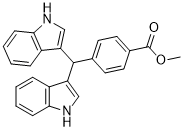DIM-C-pPhCO2Me is an antagonist of the nuclear receptor 4A1 (NR4A1) with potential antineoplastic activity. In cancer cell lines, the orphan nuclear receptor NR4A1 demonstrates pro-oncogenic activity. NR4A1 coactivates specificity protein 1 (Sp1)-regulated pro-survival and growth-promoting genes, activates mTOR signaling, and regulates genes that maintain low oxidative stress, such as thioredoxin domain containing 5 and isocitrate dehydrogenase 1. Renal cell carcinoma (RCC) ACHN and 786-O cells transfected with NR4A1-targeting oligonucleotides exhibit a 40–60% reduction in proliferation and an induction of apoptosis. In addition, NR4A1 knockdown in RCC cells resulted in decreased expression of bcl-2, survivin, and epidermal growth factor receptors, impaired mTOR signaling, oxidative and endoplasmic reticulum stress, and decreased levels of TXNDC5 and IDH1. The p-hydroxyphenyl (DIM-C-pPhOH) and p-carboxymethyl (DIM-C-pPhCO2Me) analogs of 1,1-bis(3'-indolyl)-1-(p-substituted phenyl)methane (C-DIM) compounds have recently been shown to bind NR4A1 and function as antagonists. In ACHN and 786-O cells, DIM-C-pPhOH and DIM-C-pPhCO2Me both halted growth and caused apoptosis. The functional and genomic effects of the NR4A1 antagonists were similar to those seen following NR4A1 knockdown. These findings suggest that NR4A1 antagonists are a novel chemotherapy for the treatment of RCC because they target several growth-promoting and pro-survival pathways in RCC cells and in tumors (xenograft).
Physicochemical Properties
| Molecular Formula | C25H20N2O2 |
| Molecular Weight | 380.438506126404 |
| Exact Mass | 380.15 |
| Elemental Analysis | C, 78.93; H, 5.30; N, 7.36; O, 8.41 |
| CAS # | 151358-48-4 |
| Related CAS # | 151358-48-4 |
| PubChem CID | 15637614 |
| Appearance | Light yellow to yellow solid powder |
| LogP | 5.4 |
| Hydrogen Bond Donor Count | 2 |
| Hydrogen Bond Acceptor Count | 2 |
| Rotatable Bond Count | 5 |
| Heavy Atom Count | 29 |
| Complexity | 541 |
| Defined Atom Stereocenter Count | 0 |
| InChi Key | BBAOKSZCULLDIW-UHFFFAOYSA-N |
| InChi Code | InChI=1S/C25H20N2O2/c1-29-25(28)17-12-10-16(11-13-17)24(20-14-26-22-8-4-2-6-18(20)22)21-15-27-23-9-5-3-7-19(21)23/h2-15,24,26-27H,1H3 |
| Chemical Name | methyl 4-[bis(1H-indol-3-yl)methyl]benzoate |
| Synonyms | DIM-C-pPhCO2Me; DIM-C pPhCO2Me; DIM C-pPhCO2Me |
| HS Tariff Code | 2934.99.9001 |
| Storage |
Powder-20°C 3 years 4°C 2 years In solvent -80°C 6 months -20°C 1 month |
| Shipping Condition | Room temperature (This product is stable at ambient temperature for a few days during ordinary shipping and time spent in Customs) |
Biological Activity
| Targets | Nuclear receptor 4A1 (NR4A1) |
| ln Vitro | inactivation of NR4A1 by the receptor antagonist DIM-C-pPhOH or the corresponding p-carboxymethyl analog (DIM-C-pPhCO2Me) decreases expression of genes associated with cell proliferation and survival, induces oxidative stress, and inhibits mTOR in cancer cell lines[1] |
| Cell Assay |
Cells were seeded and subsequently treated with varying concentrations of DIM-C-pPhOH or DIM-C-pPhCO2Me for 24 hr or transfected with 100 nM siNR4A1 for 72 hr, and whole cell lysates were analyzed by western blot analysis essentially as described using β-actin as the loading control .[1] ACHN RCC cells were plated on 12-well plates at 5 x 104 cells per well in DMEM supplemented with 2.5% charcoal-stripped FBS. After 24 hr, various amounts of DNA [NBRE3-luc (400 ng), FLAG-NR4A1 (40 ng)] were cotransfected into each well by Lipofectamine 2000 reagent . After 6 hr of transfection, cells were treated with 2.5% stripped DMEM containing either DMSO, DIM-C-pPhOH (20 μM) or DIM-C-pPhCO2Me (15 μM) for 18 hr. [1] |
| References |
[1]. Nuclear Receptor 4A1 (NR4A1) as a Drug Target for Renal Cell Adenocarcinoma. PLoS One. 2015 Jun 2;10(6):e0128308. |
Solubility Data
| Solubility (In Vitro) |
DMSO: ~76 mg/mL(~199.8 mM) Ethanol: ~38 mg/mL (~99.9 mM) |
| Solubility (In Vivo) |
Solubility in Formulation 1: ≥ 2.08 mg/mL (5.47 mM) (saturation unknown) in 10% DMSO + 40% PEG300 + 5% Tween80 + 45% Saline (add these co-solvents sequentially from left to right, and one by one), clear solution. For example, if 1 mL of working solution is to be prepared, you can add 100 μL of 20.8 mg/mL clear DMSO stock solution to 400 μL PEG300 and mix evenly; then add 50 μL Tween-80 to the above solution and mix evenly; then add 450 μL normal saline to adjust the volume to 1 mL. Preparation of saline: Dissolve 0.9 g of sodium chloride in 100 mL ddH₂ O to obtain a clear solution. Solubility in Formulation 2: ≥ 2.08 mg/mL (5.47 mM) (saturation unknown) in 10% DMSO + 90% (20% SBE-β-CD in Saline) (add these co-solvents sequentially from left to right, and one by one), clear solution. For example, if 1 mL of working solution is to be prepared, you can add 100 μL of 20.8 mg/mL clear DMSO stock solution to 900 μL of 20% SBE-β-CD physiological saline solution and mix evenly. Preparation of 20% SBE-β-CD in Saline (4°C,1 week): Dissolve 2 g SBE-β-CD in 10 mL saline to obtain a clear solution. (Please use freshly prepared in vivo formulations for optimal results.) |
| Preparing Stock Solutions | 1 mg | 5 mg | 10 mg | |
| 1 mM | 2.6285 mL | 13.1427 mL | 26.2854 mL | |
| 5 mM | 0.5257 mL | 2.6285 mL | 5.2571 mL | |
| 10 mM | 0.2629 mL | 1.3143 mL | 2.6285 mL |
